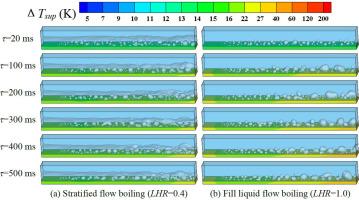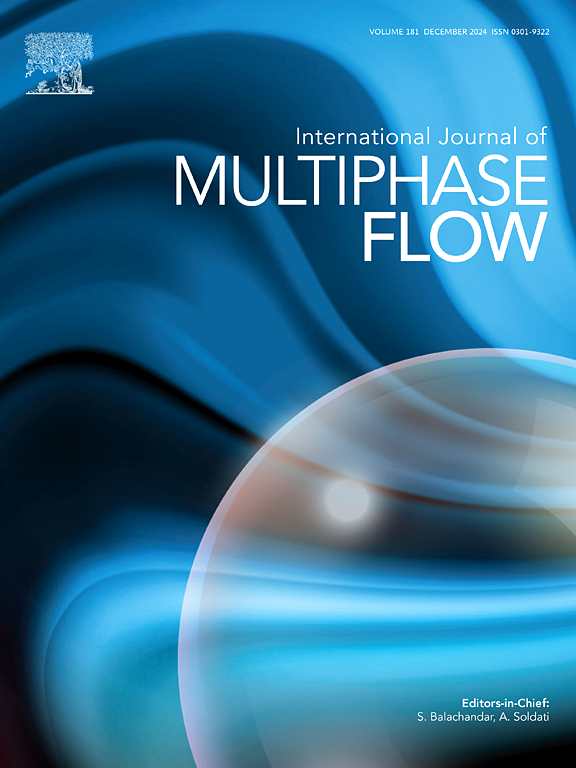Numerical simulation study on stratified flow boiling in rectangular mini-channels
IF 3.8
2区 工程技术
Q1 MECHANICS
International Journal of Multiphase Flow
Pub Date : 2025-09-15
DOI:10.1016/j.ijmultiphaseflow.2025.105447
引用次数: 0
Abstract
In this study, the flow boiling heat transfer in a rectangular mini-channel with stratified flow is investigated using the VOSET method. Different heat transfer performances are observed in stratified flow compared to fill liquid flow. The effects of merging, fluctuation, fragmentation, and lifting are observed in stratified flow boiling, which are absent in fill liquid flow. The positive fluctuation and merging effects reduce the dry patch area on the wall. Large bubbles merge into the upper vapor layer upon contacting the free surface. Meanwhile, fluctuations in the free surface reduce the detachment radius of the bubbles and increase their detachment frequency. These positive effects lead to a reduction in wall superheat by up to 27.86 %. However, at high heat fluxes, negative fragmentation effect emerges. Intense boiling can cause the thin liquid film to fragment, increasing the area of dry patches. Despite this, the positive effects of merging and fluctuation still greater than the negative impact of fragmentation, resulting in a slight enhancement in overall heat transfer performance. Additionally, the liquid height ratio (LHR), defined as the ratio of the liquid film height (HL) to the channel height (H), significantly impacts stratified flow boiling. For thicker liquid films, the heating wall is isolated by the vapor because of the negative lifting effect. This lifting effect drastically reduces the rewetting of the heating wall, leading to a significant deterioration in overall heat transfer performance. However, this negative lifting effect can be mitigated by adjusting the LHR. In practical operations, adjusting the liquid level height can promote heat transfer performance in mini-channel flow boiling.

矩形小通道分层流沸腾的数值模拟研究
本文采用VOSET方法研究了矩形微通道分层流动中的流动沸腾换热问题。在分层流动中观察到不同于填充液体流动的换热性能。在分层流沸腾中观察到合并、波动、破碎和提升效应,而在充填液流动中则没有。积极的波动和合并效应减少了壁面上的干斑面积。大气泡在接触自由表面时并入上层蒸汽层。同时,自由表面的波动减小了气泡的分离半径,增加了气泡的分离频率。这些积极的影响导致壁面过热度降低高达27.86%。然而,在高热通量下,出现了负破碎效应。强烈的沸腾会导致薄的液体膜破裂,增加干燥斑块的面积。尽管如此,合并和波动的积极影响仍然大于破碎的负面影响,导致整体传热性能略有提高。此外,液高比(LHR),即液膜高度(HL)与通道高度(H)之比,显著影响分层流沸腾。对于较厚的液膜,由于负提升效应,加热壁被蒸汽隔离。这种提升效应大大减少了加热壁的再润湿,导致整体传热性能的显着恶化。然而,这种负面的抬升效应可以通过调整LHR来缓解。在实际操作中,调整液位高度可以提高小通道流动沸腾的换热性能。
本文章由计算机程序翻译,如有差异,请以英文原文为准。
求助全文
约1分钟内获得全文
求助全文
来源期刊
CiteScore
7.30
自引率
10.50%
发文量
244
审稿时长
4 months
期刊介绍:
The International Journal of Multiphase Flow publishes analytical, numerical and experimental articles of lasting interest. The scope of the journal includes all aspects of mass, momentum and energy exchange phenomena among different phases such as occur in disperse flows, gas–liquid and liquid–liquid flows, flows in porous media, boiling, granular flows and others.
The journal publishes full papers, brief communications and conference announcements.

 求助内容:
求助内容: 应助结果提醒方式:
应助结果提醒方式:


